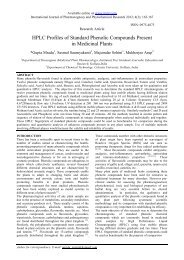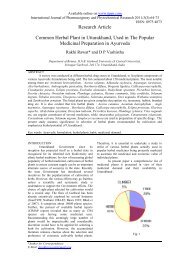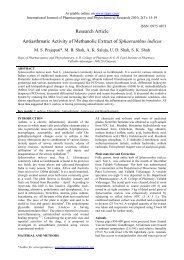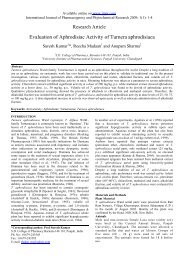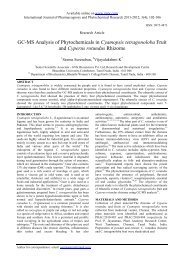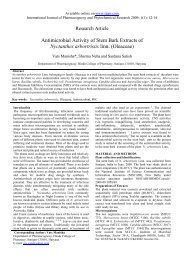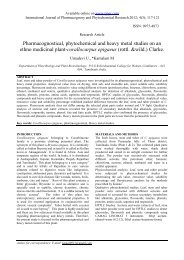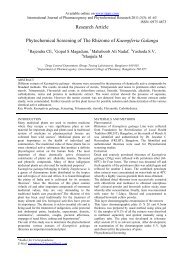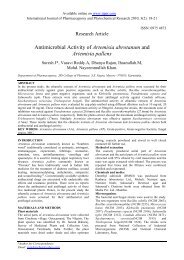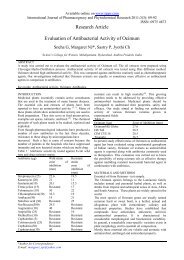pharmacognostical studies on root tubers of chlorophytum ...
pharmacognostical studies on root tubers of chlorophytum ...
pharmacognostical studies on root tubers of chlorophytum ...
Create successful ePaper yourself
Turn your PDF publications into a flip-book with our unique Google optimized e-Paper software.
Available <strong>on</strong>line <strong>on</strong> www.ijppr.comInternati<strong>on</strong>al Journal <strong>of</strong> Pharmacognosy and Phytochemical Research 2010; 2(4):13-17Research ArticleISSN: 0975 4873Pharmacognostical Studies On Root Tubers Of ChlorophytumBorivilianum Santapau & FernandesPanda S.K. 1* , Das D. 2 , and Tripathy N.K. 31 The Pharmaceutical College, Samaleswari Vihar, Tingipali, Barpali-7680292 School <strong>of</strong> Pharmaceutical Sciences, SOA University , Bhubaneswar –7510303 Department <strong>of</strong> Zoology, Berhampur University, Berhampur – 760 007ABSTRACTThe <strong>root</strong> <strong>tubers</strong> <strong>of</strong> Chlorophytum borivilianum Sant & Fern (Safed Musli) (Liliaceae) are reported to have a greatermedicinal value. Pharmacognostic evaluati<strong>on</strong> including examinati<strong>on</strong> <strong>of</strong> morphological and microscopical characters,determinati<strong>on</strong> <strong>of</strong> ash values, swelling & foaming index, extractive values, moisture c<strong>on</strong>tent and fluorescencecharacteristics <strong>of</strong> powder drug with different chemical reagents was carried out.Keywords: Safed musli, Chlorophytum borivilianum, Traditi<strong>on</strong>al System <strong>of</strong> medicine, Aphrodisiac,Pharmacognostical.INTRODUCTIONChlorophytum Ker-Gawl (Liliaceae) is a genus <strong>of</strong> shortrhizomatous herbs, distributed in the tropical and subtropicalregi<strong>on</strong>s <strong>of</strong> the world. About 17 species occurs inIndia, <strong>of</strong> which some are grown for ornament purpose<strong>on</strong>ly 1 . Chlorophytum borivilianum Sant. & Fern. <strong>root</strong><strong>tubers</strong> are known as ‘Safed musli’ and used forrheumatic and nervous complaints and also useful indiabetes 2 . The <strong>root</strong> is used as a t<strong>on</strong>ic 3 . In the traditi<strong>on</strong>alsystem <strong>of</strong> medicine, Safed musli is used as t<strong>on</strong>ic forgeneral debility and also as Aphrodiasiacs. Safed musalic<strong>on</strong>tains 39 to 42% <strong>of</strong> Carbohydrates, Proteins 8 to 12%,Sap<strong>on</strong>in 2 - 4%, Sapogenin (hicogenin) 0.18 to 0.2%;several rare elements like zinc, copper and phosperous,fibers c<strong>on</strong>tent <strong>of</strong> the <strong>root</strong>s is about 3 to 5% 4 . A very lessnumbers <strong>of</strong> research findings were reported <strong>on</strong> this plant,especially no systematic Pharmacognostical <str<strong>on</strong>g>studies</str<strong>on</strong>g> hasbeen reported. Therefore, present investigati<strong>on</strong> wasplanned to study the Pharmacognostical aspects <strong>of</strong> C.borivilianum <strong>root</strong> <strong>tubers</strong>.MATERIALS AND METHOD -Authenticated planting materials were collected throughNBPGR (ICAR) from NRC for M & AP, Anand, Gujratbearing DS no. 413 dated 5 th July 2004. The plantingmaterials were used for cultivati<strong>on</strong> by following thestandard method and harvested in time to get better yieldand more Percentage <strong>of</strong> active principles. The voucherspecimen preserved in laboratory for future references.The <strong>root</strong> <strong>tubers</strong> were made free from aerial parts & wiry<strong>root</strong>lets and thoroughly washed under running tap waterto remove adherent dirt materials, then peeled & shadedried. Few samples <strong>of</strong> <strong>root</strong> <strong>tubers</strong> were stored informalin aceto-alcohol soluti<strong>on</strong> and out <strong>of</strong> remaining,few kept as such i.e. entire form and others are powderedto #40 and stored in airtight glass c<strong>on</strong>tainers 5, 6 .Free hand transverse secti<strong>on</strong>s <strong>of</strong> the <strong>root</strong> <strong>tubers</strong> weretaken from the preserved material observed undermicroscope and photographs taken in VIVITAR camera,Japan.Stored entire and fine powder <strong>of</strong> <strong>root</strong> <strong>tubers</strong> were takenfor the <str<strong>on</strong>g>studies</str<strong>on</strong>g> <strong>of</strong> macroscopical & microscopicalcharacter & Fluorescence characteristics <strong>of</strong> the drug withdifferent chemical reagents observed under day & UVlight <strong>of</strong> short & l<strong>on</strong>g wave length.All standard procedure were followed as per thereferences for <str<strong>on</strong>g>studies</str<strong>on</strong>g> <strong>of</strong> characteristics like presence <strong>of</strong>Total Ash, Acid insoluble Ash, Water soluble Ash,Alcohol soluble extractive value, water solubleextractive value, Swelling and foaming index, Moisturec<strong>on</strong>tent and qualitative chemical test for presence <strong>of</strong>sec<strong>on</strong>dary metabolites 7,8 .RESULTSMacroscopical StudiesThe fresh <strong>root</strong>s are directly cylindrical, originates fromthe stem disc, devoid <strong>of</strong> any fibrous structure andcylindrical in shape with tapering ends. The tubernumbers are 5-20, about 6-14 cm in length and 8-12 mmin diameter. Few wiry <strong>root</strong>lets are at the lower side andcolour earthy brown externally & white to buff-whiteinternally. The odour is faint and characteristic withmucilaginous test. (Fig-1 & 2)The peeled and dried <strong>root</strong> is tuberous &cylindrical with tapering ends, swelling c<strong>on</strong>siderablywhen socked in water and are white to dull white incolour. The odour is faint and characteristic withmucilaginous taste. The surface is rough showing signs*Author for Corresp<strong>on</strong>danceEmail: skpanda2006@rediffmail.com , pr<strong>of</strong>.skpanda@gmail.com
Panda et.al. / Pharmacognostical <str<strong>on</strong>g>studies</str<strong>on</strong>g> <strong>on</strong> <strong>root</strong> <strong>tubers</strong> <strong>of</strong> Chlorophytum borivilianum…Fig 1: Fresh <strong>root</strong> <strong>tubers</strong> <strong>of</strong> C. borivilianum with CrownFig 2: Collected fresh <strong>root</strong> <strong>tubers</strong> <strong>of</strong> C. borivilianumFig 3: Fresh peeled <strong>root</strong> <strong>tubers</strong> <strong>of</strong> C. borivilianum<strong>of</strong> shrinkage when dry and texture is hard. Thesize <strong>of</strong> <strong>tubers</strong> are about 4-8 cm in length and 4-8 mm indiameter. (Fig-3 & 4)Microscopical StudiesThe T.S. <strong>of</strong> unpeeled <strong>root</strong> tuber shows the presence <strong>of</strong>Epiblema <strong>of</strong> single layer thin walled cells <strong>of</strong> which outerwalls extended outwards and form unicellular <strong>root</strong> hairs(Fig-5). The other characteristics are similar to peeled<strong>on</strong>e.The T.S. <strong>of</strong> preserved peeled sample devoid <strong>of</strong>epiblema shows layer <strong>of</strong> cortex c<strong>on</strong>sists <strong>of</strong> many layers<strong>of</strong> thin walled rounded to polyg<strong>on</strong>al parenchymatous andhave little or no intercellular spaces (Probably due toswelling) . The inner most layer <strong>of</strong> cortex is a singleIJPPR December - February 2010, Volume 2, Issue 4 (13-17) 14
Panda et.al. / Pharmacognostical <str<strong>on</strong>g>studies</str<strong>on</strong>g> <strong>on</strong> <strong>root</strong> <strong>tubers</strong> <strong>of</strong> Chlorophytum borivilianum…Fig 4: Dried peeled <strong>root</strong> <strong>tubers</strong> <strong>of</strong> C. borivilianumFig 5: T.S. <strong>of</strong> C.borivilianum <strong>root</strong> tuber (Cortex regi<strong>on</strong>)Fig 6: T.S. <strong>of</strong> C. borivilianum <strong>root</strong> tuber (Stele regi<strong>on</strong>)layer endodermis followed by a uniseriatepericycle layer <strong>of</strong> thin walled cells.The vascular tissue is not elaborate. The Xylemis exarch and c<strong>on</strong>sists <strong>of</strong> jointed vessels, 3-5 in numberIJPPR December - February 2010, Volume 2, Issue 4 (13-17) 15
Panda et.al. / Pharmacognostical <str<strong>on</strong>g>studies</str<strong>on</strong>g> <strong>on</strong> <strong>root</strong> <strong>tubers</strong> <strong>of</strong> Chlorophytum borivilianum…Fig 7: L.S. <strong>of</strong> C. borivilianum <strong>root</strong>tuber (Stele regi<strong>on</strong>)Fig 8 : Fibers and vessels <strong>of</strong> C.borivilianum <strong>root</strong> tuber powderFig 9: Vessels <strong>of</strong> C. borivilianum <strong>root</strong>tuber powderFig 10: Fibers <strong>of</strong> C. borivilianum<strong>root</strong> tuber powderFig 11: Cortex <strong>of</strong> C. borivilianum<strong>root</strong> tuber powderFig 12:St<strong>on</strong>e cell <strong>of</strong> C. borivilianum<strong>root</strong> tuber powderin each group. However, Xylem fibres are quiteabundant, surrounding the vessels and jointed to form amore or less c<strong>on</strong>tinuous irregular ring, xylery fibres arenot uniform at all places. The phloem is grouped inbetween the arches <strong>of</strong> the xylery tissue al<strong>on</strong>g withparenchyma. The central regi<strong>on</strong> is occupied by a fairlylarge pith regi<strong>on</strong>, where the cells are closely packed as incortical regi<strong>on</strong> and mostly <strong>of</strong> polyg<strong>on</strong>al in shape 6, 7 .(Fig- 6 & 7)Powder Characteristic StudiesThe <strong>root</strong> tuber powder <strong>of</strong> C. borivilianum is buffcoloured having mucilagenous, salty and sticky in taste.The powder microscopical characters <strong>of</strong> C. borivilianumshows characters like large cortex z<strong>on</strong>e, fibres in groupsand associated with the vessels, thin walled & fairlylarge with numerous pits, vessels occur in small groupsand associated with fibres, reticulately thickened andpitted and presence <strong>of</strong> st<strong>on</strong>e cells with simple pits <strong>on</strong>their walls. (Fig 8 - 12).Florescence Characteristics StudiesThe behavior and florescence characteristics <strong>of</strong> C.borivilianum <strong>root</strong> <strong>tubers</strong> Powder with different reagentswere studied under day light, U.V light at 254 nm and365nm and observati<strong>on</strong> were recorded in Table-1DISCUSSIONThe macroscopical examinati<strong>on</strong> <strong>of</strong> the <strong>root</strong> revealedvertical directi<strong>on</strong> <strong>of</strong> the growth (positively geographic).The drug is having adventitious <strong>root</strong>s system and havingfasciculated <strong>tubers</strong> <strong>root</strong>s.Microscopical examinati<strong>on</strong>s <strong>of</strong> C. borivilinum<strong>root</strong> <strong>tubers</strong> revealed the presence <strong>of</strong> epiblema <strong>of</strong>thickened and swollen walls due to silicious depositi<strong>on</strong>and rounded in shape. This structure is absent in peeleddrug. This is followed by a very large z<strong>on</strong>e <strong>of</strong> cortex.The outermost layer <strong>of</strong> the cortex and just belowepiblema two layers <strong>of</strong> rectangular cell found which arehypodermis much l<strong>on</strong>ger than wide. The rest <strong>of</strong> thecortical cells are rounded to polyg<strong>on</strong>al, parenchymatousand have little or no intercellular spacesprobable due to swelling. The innermost layer <strong>of</strong> cortexis a single layer endodermis.The stellar structure shows that the endodermisis followed by a uniserate pericycle layer. The vasculartissue is not very elaborate. The xylem is exarch andc<strong>on</strong>sists <strong>of</strong> jointed vessels, 3-5 in number in each group.There are about 30-35 groups <strong>of</strong> xylem. However, xyleryfibers are quite abundant, surrounding the vessels andjointed to form a more or less c<strong>on</strong>tinuous irregular Ring.The specific characters like presence <strong>of</strong>unicellular <strong>root</strong> hairs undifferentiated cortex, radialarrangement <strong>of</strong> vascular bundles and exarches nature <strong>of</strong>xylem are the <strong>root</strong> characters and presence <strong>of</strong> more thensix numbers <strong>of</strong> radial vascular bundles andpresence <strong>of</strong> large & distinct pith are the characters <strong>of</strong>m<strong>on</strong>ocot <strong>root</strong>s.IJPPR December - February 2010, Volume 2, Issue 4 (13-17) 16
Panda et.al. / Pharmacognostical <str<strong>on</strong>g>studies</str<strong>on</strong>g> <strong>on</strong> <strong>root</strong> <strong>tubers</strong> <strong>of</strong> Chlorophytum borivilianum…Table-1: Behaviour and florescence characteristics <strong>of</strong> C. borivilianum <strong>root</strong> Tubers PowderS.No. Treatment Colour <strong>of</strong> power inday lightU V light in Short(254nm)U V light inl<strong>on</strong>g (356nm)1 Powder drug as such (Untreated powder) Whitish Dull blue Blue2 Powder drug treated with saturated picric Yellowish Green Violetacid soluti<strong>on</strong>3 Powder drug treated with nitric acid Light yellowish Faint yellow Blue4 Powder drug treated with hydrochloricacid5 Powder drug treated with c<strong>on</strong>c. sulphuricacid6 Powder drug treated with glacial aceticacid7 Powder drug treatrd with sodiumhydroxide (5N aqueous)8 Powder drug treated with Iodine (N/20aqueous)9 Powder drug treated with ferric chlorideWhitish buff Dull blue BlackTurns chocolate BlackBlackbrownWhitish Dull blue BlackChary Brown Dull yellow VioletReddish brown Yellow Black BlackYellowish brownDeep green toBlackBlackThe microscopy findings revealed about theabsence <strong>of</strong> starch grains. Further, this has beenc<strong>on</strong>firmed by treated the powder drug with aqueous 1Niodine soluti<strong>on</strong>.While performing the fluorescencecharacteristics <strong>of</strong> drug powder with different chemicalreagents <strong>on</strong>ly change in colour <strong>of</strong> the drug powder wasobserved when seen under UV light. This probablyc<strong>on</strong>firms absence <strong>of</strong> any fluorescence compound in the<strong>root</strong>.The drug showed the presence <strong>of</strong> total ash 4.2%, acid insoluble ash 0.8 %, water soluble ash 1.4 %,alcohol soluble extractive 1.1% , water soluble extractive10.6%, swelling index 7.4 & foaming index 68.4% andmoisture c<strong>on</strong>tent 9.2%.The qualitative chemicals test revealed thepresence <strong>of</strong> steroids, sap<strong>on</strong>in, flav<strong>on</strong>oids, tannin, aminoacid, reducing sugar and mucilage.ACKNOWLEDGEMENTThe authors are grateful to Dr. S. Maiti, Director, NRCfor A & P and Dr. R.V. Singh, Head Germplasm <strong>of</strong>Exchange Divisi<strong>on</strong>, NBPGR, New Delhi for supplying<strong>of</strong> authentic sample. They are also thankful to Dr. A.K.Dalai., Revenshaw College and Dr. Brahmam & Dr.Sexena for IMMT (RRL), Bhubaneswar for assisting inthe work.REFERENCES1. An<strong>on</strong>ymous, “The Wealth <strong>of</strong> India”, Vol-III, CSIR,New Delhi, 1992, 482 – 483..2. Sharma R., “Medicinal Plants <strong>of</strong> India ” DayaPublishing House, Delhi, 2003, 56 – 58.3. Kirtikar K.R., Basu B.D.,“Indian Medicinal Plants,Lalit Mohan Basu publicati<strong>on</strong>s, Allahabad, 1987,2508 – 2509.4. Kokate C.K., Purohit A.P & Gokhale S.B.,“Pharmacognosy” 29 th Edn., Nirali prakashan, Pune-2, 2004, 211 – 215..5. Ashok M., Malati G., Chauhan G., Indian Journal <strong>of</strong>Natural Product., 22 (i), 3.6. Dhanabal S.P., Suresh B., Sheeja E., Edusin E.,Indian Journal <strong>of</strong> Natural Product., 21 (i), 9.7. The Indian Pharmacopoea, 2 nd Edn., Govt. <strong>of</strong> India,publicati<strong>on</strong>s, Delhi, 1966,947 - 9488. Khandelwal K.R., Practical Pharamacognosy 14 thEdn., Nirali Prakashan, Pune, 2005, 149, 157.IJPPR December - February 2010, Volume 2, Issue 4 (13-17) 17



